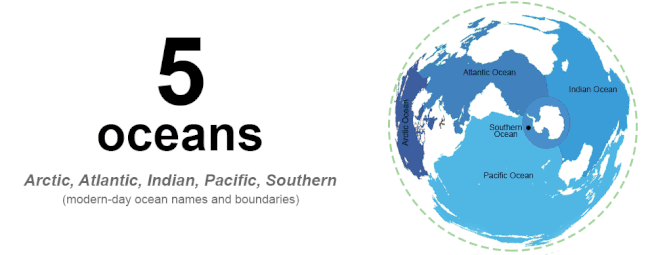Oceans of the world
The World Ocean
There is only one World (or global) Ocean however the vast body of water that covers 71 percent of the Earth is geographically divided into distinct named regions.
The boundaries between these regions have evolved over time for a variety of historical, cultural, geographical, and scientific reasons.
How many oceans are there?

Historically, there are four named oceans:
(1) the Atlantic ocean
(2) the Pacific ocean
(3) the Indian ocean
(4) the Arctic ocean
However, most countries - including the United States - now recognize the Southern (Antarctic) as the fifth ocean.
The Pacific, Atlantic, and Indian are known as the three major oceans.
The Seas of the World
Arctic Ocean:
Barents Sea
Beaufort Sea
Chukchi Sea
East Siberian Sea
Greenland Sea
Kara Sea
Laptev Sea
Lincoln Sea
Pacific Ocean:
Arafura Sea
Banda Sea
Bering Sea
Bismarck Sea
Celebes Sea
Chilean Sea
Coral Sea
East China Sea
Gulf of Alaska
Sea of Japan
Molucca Sea
Sea of Okhotsk
Philippine Sea
Solomon Sea
South China Sea
Sulu Sea
Tasman Sea
Yellow Sea
This is not a complete list.
Atlantic Ocean:
Black Sea
Caribbean Sea
Greenland Sea
Gulf of Guinea
Labrador Sea
Mediterranean Sea
North Sea
Norwegian Sea
Sargasso Sea
Indian Ocean:
Arabian Sea
Bay of Bengal
Timor Sea
Southern Ocean:
Amundsen Sea
Ross Sea
Scotia Sea
Weddell Sea
The Global Continental Shelf
The continental shelf is an underwater landmass which extends from a continent, resulting in an area of relatively shallow water known as a shelf sea.
The continental margin, between the continental shelf and the abyssal plain, comprises a steep continental slope followed by the flatter continental rise.

![The global continental shelf, highlighted in cyan, defines the extent of coastal habitats, and occupies 5% of the total world area. Tap to view in full size. Source: By GEBCO world map 2014 (public domain) - [1] doi:10.3389/fmars.2019.00241, CC0, https:/](https://image.jimcdn.com/app/cms/image/transf/dimension=478x10000:format=jpg/path/s6ecaf51f4042b407/image/i106834cf746e5d03/version/1629628412/the-global-continental-shelf-highlighted-in-cyan-defines-the-extent-of-coastal-habitats-and-occupies-5-of-the-total-world-area-tap-to-view-in-full-size-source-by-gebco-world-map-2014-public-domain-1-doi-10-3389-fmars-2019-00241-cc0-https.jpg)
Resources:
The World Ocean modified from: http://oceanservice.noaa.gov/facts/howmanyoceans.html
The global continental shelf modified from :https://en.wikipedia.org/wiki/Continental_shelf

 Marine Science Australia
Marine Science Australia
